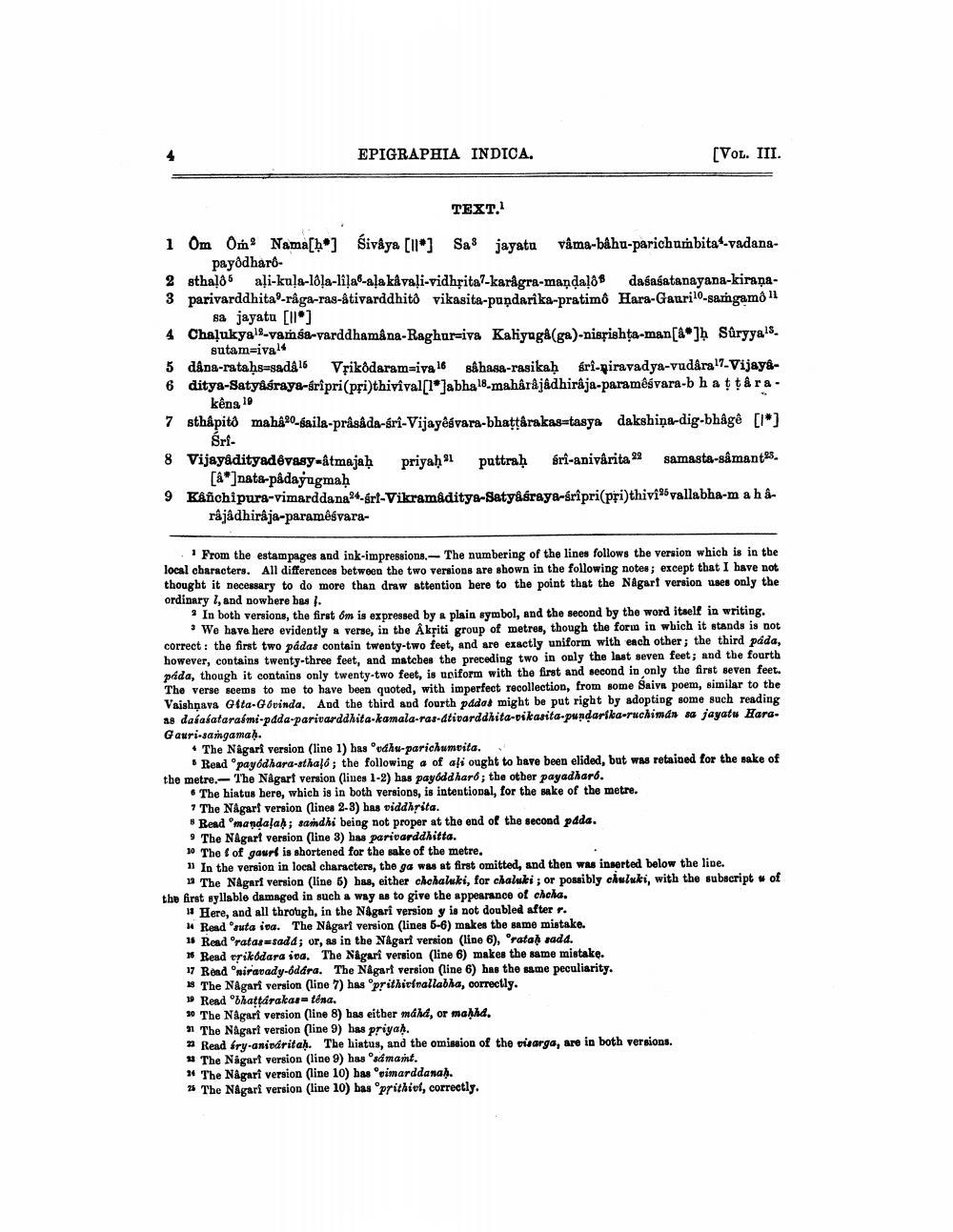________________
EPIGRAPHIA INDICA.
(VOL. III.
TEXT.
1 Om Om Nama[ho] Sivaya [ll] Sal jayata vâma-båhu-parichurbita -vadana
payðdharo2 sthaļ86 ați-ku!a-18?a-liļak-aļa kávali-vidhřita7-karagra-manda!88 daśasatanayana-kirana3 parivarddhita-råga-ras-&tivarddhit8 vikasita-puņdarika-pratimô Hara-Gauril-samgamo
sa jayatı [11] 4 Chaļukyal-vaṁśa-varddhamâna-Raghur=iva Kaliyuga(ga)-nisçishta-man[de]Süryyals.
sutam=ival4 5 dâna-rataḥs=sad 16 Vpikodaramaiva 16 sâhasa-rasikaḥ sri-piravadya-vudára 7.Vijaya6 ditya-Satyasraya-sripri(pri)thivival[l*]abha18-mahârâjâdhiraja-paramêsvara-b hatt&ra.
kena 19 7 sthâpito maha?o-saila-prâsâda-fri-Vijayêśvara-bhađârakas=tasya dakshina-dig-bhâge [l*]
Sri. 8 Vijayadityadêvagy-âtmajaḥ priyaḥ puttraḥ sri-anivärita 22 samasta-samant.
[A]nata-pâdayugmaḥ 9 Kanchipura-vimarddana 4-rt-Vikramaditya-Satyåśraya-sripri(pri)thiviavallabha-m a h â
râjâdhiraja-paramêśvara
From the estampages and ink-impressions. The numbering of the lines follows the version which is in the local characters. All differences between the two versions are shown in the following notes; except that I have not thought it necessary to do more than draw attention here to the point that the Nagarf version uses only the ordinary 1, and nowhere bas 1.
. In both versions, the first 6m is expressed by a plain symbol, and the second by the word itself in writing.
• We have here evidently a verse, in the Åkriti group of metres, though the form in which it stands is not correct: the first two pádas contain twenty-two feet, and are exactly uniform with each other; the third pada, however, contains twenty-three feet, and matches the preceding two in only the last seven feet; and the fourth pada, though it contains only twenty-two feet, is upiform with the first and second in only the first seven feet. The verse seems to me to have been quoted, with imperfect recollection, from some Saiva poem, similar to the Vaishņavs Gita-Govinda. And the third and fourth padat might be put right by adopting some such reading as darajatarahmi-pada-paritarddhita.kamala-ras-dlivarddhita-pikasita pundarska-ruchiman sa jayatu Hara. Gauri-samgama).
• The Någari version (line 1) has udhu-parichumvita.
* Read payodhara-athal; the following a of ali ought to have been elided, but was retained for the sake of the metre.- The Nägarf version (lines 1-2) has payóddhar6; the other payadharo.
• The hintus here, which is in both versions, is intentional, for the sake of the metre. 7 The Nagart version (lines 2-8) has viddhrita. * Read mandalah; samdhi being not proper at the end of the second pdda. 9 The Någart version (line 3) has parivarddhitta. 30 Thef of gaurl is shortened for the sake of the metre.
In the version in local characters, the ga was at first omitted, and then was inserted below the line.
1 The Nagari version (line 5) bas, either chohaluki, for chaluki; or possibly chuluki, with the subscript of the first syllable damaged in such a way as to give the appearance of cheha.
1 Here, and all through, in the Nagari version y is not doubled after # Read 'suta ina. The Nagari version (lines 5-6) makes the same mistake. 1 Read Oratas=sadd; or, as in the Nagari version (line 6), 'ratas sadd. * Read erikodara ina. The Nagari version line 6) makes the same mistake. 17 Rond niravady-odára. The Nagart version (line 6) has the same peculiarity. 1 The Nagari version (line 7) has prithivinallabha, correctly. » Read bhattárakasténa. 30 The Nagari version (line 8) has either máhá, or maḥhd. 11 The Nagari version (line 9) has priyah. 2 Read fry.aninaritaḥ. The hiatus, and the omission of the visarga, are in both versions.
The Nagart version (line 9) has samant. * The Nagari version (line 10) has rimarddanas. * The Nagari version (line 10) has oprithivi, correctly.




